Earlier this year, in the post New Works: Magical Northern Lights, I explained the genesis of a new series. These imaginary scenes depicted rocks, trees, water, skies, lakes, and northern lights, and were created using my new Holbein watercolour paints and vast photo library.
This spring and summer, I have continued to paint mythical, peaceful scenes of the north, based on memories formed over the course of my life.
I grew up near Algonquin Park in Ontario, and as an adult have explored the Canadian Shield landscape throughout northern, central, and eastern Canada on foot, in a kayak, on a snowmobile, on a motorcycle, and in our travel trailer.
In this post, I am introducing five of my recent fanciful scenes that portray morning or evening skies and feature the colour pink.

Rhapsody in Hues, varnished watercolour on 9 x 12 inch panel
I began this painting by masking out the stars and creating the background swirls. I built up layers of pale yellow, red, blue, purple and black, letting each layer of colour dry for several hours before adding the next. The masking was removed and trees were added onto dry paper at the end of the process.
This painting was inspired by a previous work Awakening, which had the three-tree cluster on the right side. For Rhapsody in Hues, I added the majestic tree on the right side for balance.
For more information about Rhapsody in Hues, click here.

Still Standing, varnished watercolour on 8 x 8 inch panel
This scene was inspired by many small, rocky islands I have seen on Lake Superior and Lake of the Woods and was painted with a similar strategy to Rhapsody in Hues.
When I see trees growing on these seemingly barren hunks of rock with very little soil, I am amazed that they can find enough of a foothold to remain standing.
For more information about Still Standing, click here.


Not a Care in the World, varnished watercolour on 10 x 10 inch panel
There is something about calm northern lakes that touches the soul and brings peace, whether we are quietly fishing, kayaking, canoeing, floating, or just gazing from shore. We need to pause and appreciate these beautiful moments whenever they happen.
This painting is a re-imagining of a scene I painted a few years ago titled Old Friends. I changed the colour scheme and added a foreground tree silhouette to make the viewer feel more immersed in nature.
For more information about Not a Care in the World, click here.


Little Bit of Heaven, varnished watercolour on 8 x 8 inch panel
This scene is inspired by many rocky islands I have seen in the 30,000 Islands region of Georgian Bay.
There is something special about the vintage cabins I see, perched on these weathered rocks. The humble, sturdy dwellings make we wonder about the lucky folk who own these little bits of heaven and what their lives are like.
For more information about Little Bit of Heaven, click here.


The Promise, varnished watercolour on 10 x 8 inch panel
This sunset scene was composed of a collection of vintage white pines I photographed in the Temagami region of northern Ontario.They tower above the surrounding forest, making for an impressive sight I admire every time we drive through that region.
The title refers to the saying 'Red sky at night, Sailor's delight', which promises good weather the day following a rosy sunset.
For more information about The Promise, click here.
I hope you have enjoyed this tour of my latest paintings of fanciful northern scenery.
Which painting is your favourite? If you have comments you wish to share, please do so using the 'Leave a Comment' button at the top of this post.
Subscribe to Karen's Newsletter if you wish to see more of her painting stories, travel tales, studio news updates, or notices of upcoming exhibitions.

 Over the past winter and spring, I have devoted myself to building a fresh collection of landscape paintings, destined for display and sale at my retail gallery partners.
Over the past winter and spring, I have devoted myself to building a fresh collection of landscape paintings, destined for display and sale at my retail gallery partners. Living the Dream, varnished watercolour on 12 x 12 inch panel
Living the Dream, varnished watercolour on 12 x 12 inch panel Quality Time, varnished watercolour on 9 x 12 inch panel
Quality Time, varnished watercolour on 9 x 12 inch panel Daybreak, varnished watercolour on 10 x 10 inch panel
Daybreak, varnished watercolour on 10 x 10 inch panel Dancing in the Dark, varnished watercolour on 12 x 12 inch panel
Dancing in the Dark, varnished watercolour on 12 x 12 inch panel  Steadfast and True, varnished watercolour on 16 x 12 inch panel
Steadfast and True, varnished watercolour on 16 x 12 inch panel 








 I decided to spend a few months this winter and spring focusing on painting cloudy sunset scenes, to try to determine where I had been going wrong in the past, and figure out what strategies might work better.
I decided to spend a few months this winter and spring focusing on painting cloudy sunset scenes, to try to determine where I had been going wrong in the past, and figure out what strategies might work better.
 The painting was inspired by this photograph I took of the view from my bedroom window last December. The trees grow in the hedgerow between farm fields behind our house, and every morning I look out my window to absorb the beauty of nature.
The painting was inspired by this photograph I took of the view from my bedroom window last December. The trees grow in the hedgerow between farm fields behind our house, and every morning I look out my window to absorb the beauty of nature. The Wonder of It All, varnished watercolour on 6 x 12 inch panel depicts a glowing sunset over a northern lake. Sometimes I look at a splendid sky and just have to marvel at the artistry of nature. She creates the most marvellous paintings, just using light and water vapour. I am awed by the wonder of it all.
The Wonder of It All, varnished watercolour on 6 x 12 inch panel depicts a glowing sunset over a northern lake. Sometimes I look at a splendid sky and just have to marvel at the artistry of nature. She creates the most marvellous paintings, just using light and water vapour. I am awed by the wonder of it all. The painting was inspired by this photo of Six Mile Lake in Muskoka, taken by Sharon Hopkirk and used with her gracious permission.
The painting was inspired by this photo of Six Mile Lake in Muskoka, taken by Sharon Hopkirk and used with her gracious permission. I was still entranced by Sharon's gorgeous photo, and started a second attempt at painting the full scene. I took a photo at the end of each day so I could show you the layering process.
I was still entranced by Sharon's gorgeous photo, and started a second attempt at painting the full scene. I took a photo at the end of each day so I could show you the layering process.





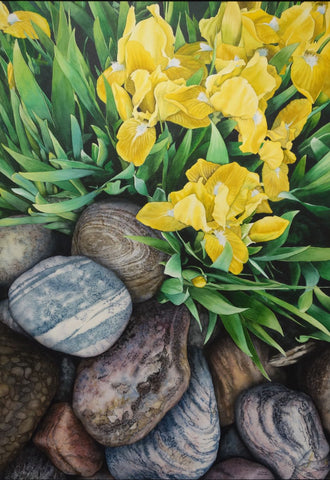 This ambitious painting project - the largest watercolour I have ever done - took me two months to create. It was pure joy to paint, if a bit intimidating, due to the large scale of the piece.
This ambitious painting project - the largest watercolour I have ever done - took me two months to create. It was pure joy to paint, if a bit intimidating, due to the large scale of the piece.





 Listen to the Silence, varnished watercolour on 14 x 11 inch panel.
Listen to the Silence, varnished watercolour on 14 x 11 inch panel.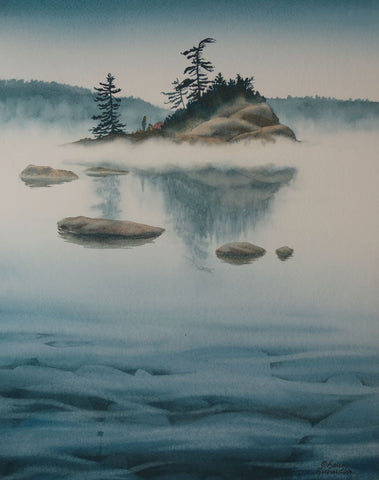

 Reunion, varnished watercolour on 10 x 10 inch panel.
Reunion, varnished watercolour on 10 x 10 inch panel. For this painting, I used her reference photo (shown here) for the foreground and invented a couple of islands to make a more interesting scene. I changed the canoe colours and decided to make the season autumn, so the trees would complement the canoes.
For this painting, I used her reference photo (shown here) for the foreground and invented a couple of islands to make a more interesting scene. I changed the canoe colours and decided to make the season autumn, so the trees would complement the canoes.

 Some Enchanted Evening, varnished watercolour on 16 x 12 inch panel.
Some Enchanted Evening, varnished watercolour on 16 x 12 inch panel. Maple Flooring, varnished watercolour on 11 x 14 inch panel.
Maple Flooring, varnished watercolour on 11 x 14 inch panel.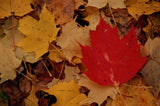









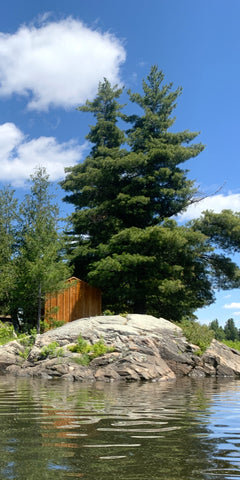

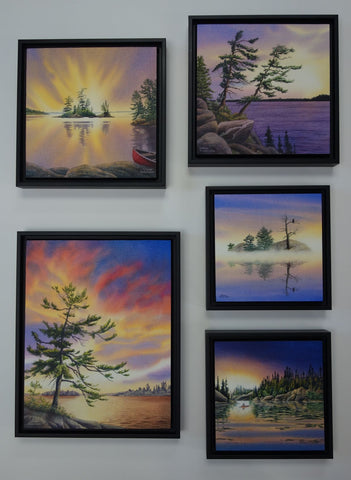

 The largest piece became Nature's Gift, varnished watercolour on 14 x 11 inch panel.
The largest piece became Nature's Gift, varnished watercolour on 14 x 11 inch panel.









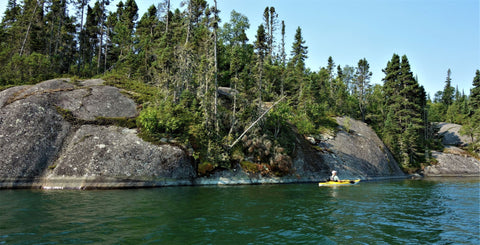

 The story began in 2016, when I spotted this pine tree with its top lopped off by a wind storm.
The story began in 2016, when I spotted this pine tree with its top lopped off by a wind storm. That same month, we saw bald eagles quite often during our boat cruises on Lake of the Woods. The eagles would perch on tall trees, looking for their next meal. I managed to photograph this one way up in a dead pine tree.
That same month, we saw bald eagles quite often during our boat cruises on Lake of the Woods. The eagles would perch on tall trees, looking for their next meal. I managed to photograph this one way up in a dead pine tree.



 The marvellous Pebble Beach in the town of Marathon on Lake Superior has inspired yet another painting.
The marvellous Pebble Beach in the town of Marathon on Lake Superior has inspired yet another painting. The scene never looks the same twice, with wind and sunlight affecting the behaviour of the waves and the colours of water and rock.
The scene never looks the same twice, with wind and sunlight affecting the behaviour of the waves and the colours of water and rock. On the subject of multiple interpretations of a given scene, here is my third painting of this northern lake with dock and red canoe.
On the subject of multiple interpretations of a given scene, here is my third painting of this northern lake with dock and red canoe.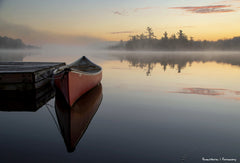 Thank you to Pamela Weston for permission to use her reference photo (shown here) in the creation of my artwork.
Thank you to Pamela Weston for permission to use her reference photo (shown here) in the creation of my artwork.


